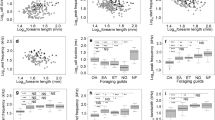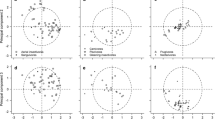Abstract
We assessed the ecomorphological structure of a guild of rhinolophoid bats in a Malaysian rainforest first described by Heller and von Helversen (1989). These authors found that the distribution of echolocation call frequencies used by 12 syntopic species was more even than expected from allometric relationships or in randomly generated communities, and that the observed minimal ratio was greater than expected by chance alone. In this study we were able to expand their guild to 15 species, but in doing so it became apparent that call frequencies might be less evenly distributed across the total frequency range than previously proposed. We replicated Heller and von Helversen’s (1989) analyses with the full 15-species complement but were unable to support their suggestion that rhinolophoid bats exhibit resource partitioning through differences in frequency bands. We adopted a multivariate approach and incorporated measures of body size and wing morphology into the analysis. We used phylogenetic autocorrelation to ensure that the species were statistically independentand principal component analysis to describe the morphological space occupied by the 15 species in the community and four additional species representing the extremes of phenotypic variation. We derived interspecific Euclidean distances and tested the mean values and SDs of these distances against those of 100 guilds of ”synthetic” species created randomly within the principal component space. The guild of Rhinolophoidea was not distributed randomly in multivariate space. Instead we found evidence of morphological overdispersion of the most similar species, which suggests niche differentiation in response to competition. Less similar species were nearer in morphological space than expected, and we suggest this is a consequence of ecological constraints on parameter combinations. Despite this underdispersion, many of the more distant neighbours were evenly rather than randomly spaced or clumped in morphospace, suggesting that, given the environmental constraints on morphology, species in this guild do experience limits to their similarity. Finally, we tested the influence of the relative abundance of species on morphological displacement, and found no evidence that abundant, spatially correlated species reduce interspecific overlap in morphological space.
Similar content being viewed by others
Author information
Authors and Affiliations
Additional information
Received: 10 April 1999 / Accepted: 28 February 2000
Rights and permissions
About this article
Cite this article
Kingston, T., Jones, G., Zubaid, A. et al. Resource partitioning in rhinolophoid bats revisited. Oecologia 124, 332–342 (2000). https://doi.org/10.1007/PL00008866
Issue Date:
DOI: https://doi.org/10.1007/PL00008866




